| dc.description.abstract | The object of this thesis is to investigate the use of scaling laws for Permanent Magnet Generators (PMGs). The product is a graphical tool named the Scaling Program, which is created in MATLAB GUIDE. The most applicable of the investigated scaling laws have been implemented in the program. The scaling laws for mass are based on work by Henk Polinder from TU Delft and the scaling laws for power and losses are based on general theory of losses in PMGs. The main contribution of the thesis is to make these scaling laws available to a user through the Scaling Program.
The philosophy of the thesis is to make realistic predictions about a given reference machine, with input data limited to that which can be expected to be handed over by a generator supplier.
The implemented scaling laws are able to predict the total mass as a function of the power of the generator, as well as the losses and efficiency as a function of the length and air gap diameter of the generator. The user can also manually compare power density and torque density with state of the art wind power generators. In addition the user can change parameters such as the specific cost of materials ratio of resistive losses to iron losses. This way, the output can be more finely tuned if more detailed information about the reference generator is available. The use of some aspects of the program is showcased in a section called Practical Examples. However, the user is encouraged to try out the program independently of the example.
Two different philosophies are discussed concerning which parameters to change with the diameter of a reference machine. One is to keep the number of poles and slots constant while changing the pole and slot geometries with the diameter. The other is to keep the pole and slot geometries constant, and only increase the number of slots and poles as the circumferential length increase with the diameter. The first procedure opens a range of possibilities on how to change the geometry, which will alter the electromagnetic properties of the machine. Since the generator is thought to already be optimally designed in electromagnetic terms, the first procedure is deemed unpractical. Therefore only the last philosophy is applied in the scaling theory.
MATLAB GUIDE is deemed to be a good tool for creating a "moderately complex" graphical user interface, which the Scaling Program can be defined as. Its versatile handling of graphical objects is especially useful.
Regarding the scaling laws, the scaling of the output power is according to the theory. With a constant tangential stress, a larger rotor volume increases the output power.
The scaling of the losses are shown to be more crude than necessary. According to the presented theory of losses in an electrical machine, the iron losses are dependant on the angular frequency, which for a PMG is assumed to be increasing with diameter. The use of the developed "ring-loss-method" neglects such a dependancy.
The estimated efficiency increases with diameter as expected since the theory states that the output power increases with the second power of the diameter, while the losses increase with the first power of the diameter. The estimated efficiency is independent of independent of the active length. This is thought to be due to the inaccuracies in the loss-ring-method.
The scaling of the mass results in similar characteristics as the paper, which the method is based on. This is however not considered a sufficient verification. Because mass of commercial multi megawatt PMGs are not available, it is difficult to verify the scaling of mass.
It is difficult to verify a scaling law for wind power generators because the power levels of commercial generators today are not very large. One way could be to build a finite element model of the reference generator and implement the scaling laws into the model. This is work intensive and outside of the scope of this thesis. Another way could be to find two generators of similar design, one with a lower power rating than the other. Then try to scale up the smaller one to the same power rating as the larger machine, and compare the data of the two. This was attempted, but data on two such similar generators were not found for this thesis. Both verification methods are suggested as further work.
Even though the scaling results are subjects to uncertainty due to its simplified approach the tool is deemed to fulfil its objective of showing the user which trends to expect if a reference machine is to be scaled up or down to a given power rating or geometry. | |

